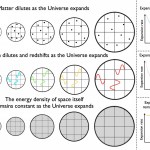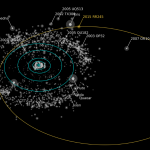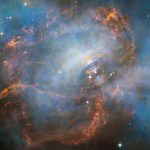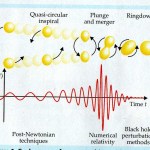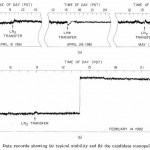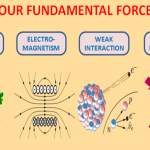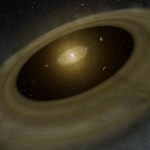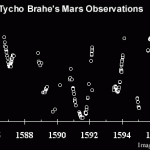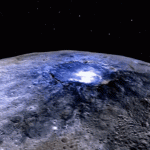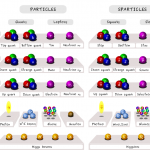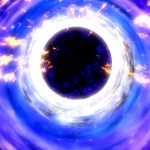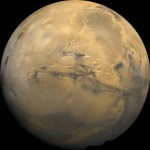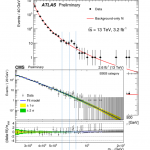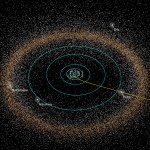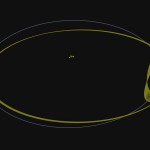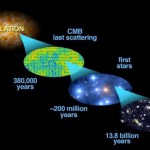
"If you're puzzled by what dark energy is, you're in good company." -Saul Perlmutter
The accelerated expansion of our Universe was one of the biggest surprise discoveries of all-time, and something that still lacks a good physical explanation. While many models of dark energy exist, it remains a completely phenomenological study: everything appears consistent with a cosmological constant, but nothing appears to be a good motivator for why the Universe should have one.
How energy density changes over time in a Universe dominated by matter (top), radiation (middle), and a cosmological constant…
"There have only been two true planets discovered since ancient times, and this would be a third. It's a pretty substantial chunk of our solar system that's still out there to be found, which is pretty exciting." -Mike Brown, on the possibility of Planet Nine
When most people think of the Kuiper belt, they think of a population of objects just beyond Neptune, with slightly larger, more elliptical and more inclined orbits. As new discoveries like the recent 2015 RR245 show, however, there are a great many additional objects in the scattered disk with different orbital parameters that are much…
"My eureka moment was in the dead of night, the early hours of the morning, on a cold, cold night, and my feet were so cold, they were aching. But when the result poured out of the charts, you just forget all that. You realize instantly how significant this is—what it is you’ve really landed on—and it’s great!" -Jocelyn Bell-Burnell, on the discovery of the first pulsar
Nearly 1,000 years ago, in 1054, a massive star in the constellation of Taurus, invisible at some 6,500 light years away, exploded in a type II supernova. Today, its remnant measures 10 light years across, while its inner core…
“According to well-known electrodynamic laws, an electron moving in a magnetic field is acted upon by a force which runs perpendicular to the direction of motion of the electron and to the direction of the magnetic field, and whose magnitude is easily determined.” -Pieter Zeeman
We're now full-on into summer here at Starts With A Bang, but that doesn't mean that science slows down at all! Our podcasts are killer with a new one coming soon, the 4th of July has just passed giving way to a huge slew of fantastic outdoor activities, and we've spent the first half of last week…
“I found I could say things with color and shapes that I couldn’t say any other way — things I had no words for.” –Georgia O’Keeffe
The Standard Model is great at describing all the known particles we've ever observed and how they interact, but there are a number of important hints that it isn't all there is in the Universe. The existence of dark matter, dark energy, neutrino masses, the matter-antimatter asymmetry, the strong-CP and hierarchy problems all tell us that this collection of quarks, leptons, their antiparticles and the bosons we know are only part of the story.
The particles and…
“It is possible to commit no mistakes and still lose. That is not a weakness. That is life.” -Jean-Luc Picard
The laws of electromagnetism could have been incredibly different. Our Universe has two types of electric charge (positive and negative) and could have had two types of magnetic pole (north and south), but only the electric charges exist in our Universe. At a fundamental level, between electricity and magnetism, nature is not symmetric.
The electric/magnetic symmetric version of Maxwell’s equations, where both electric and magnetic sources (and currents) exist. Image credit: Ed…
"Even if there is only one possible unified theory, it is just a set of rules and equations. What is it that breathes fire into the equations and makes a universe for them to describe?" -Stephen Hawking
One of the greatest discoveries of the 20th centuries was not only that there were just four fundamental forces describing all of nature, but that two of them — the electromagnetic and the weak force — unify into a single "electroweak" force at high energies. Given the equivalences between electric charges in the strong nuclear force sector and the electroweak sector, could there be a grand…
"It was the Venus I had prayed to, it was my prayer, though I had no such words. They filled my eyes with tears and my heart with inexpressible joy." -Ursula Le Guin
If you were to rewind the Solar System to the very beginning, with only imperceptibly different initial conditions, how often would Earth emerge looking like it does today: teeming with life? And how often would the other worlds -- Venus or even Mars -- emerge overflowing with stable, long-term life either instead or in addition to Earth?
Protoplanetary disks, which all solar systems are thought to form with, will coalesce into…
“Philosophy of science is about as useful to scientists as ornithology is to birds.” -Richard Feynman
Writing in the New York Times on Monday, philosopher James Blachowicz argues that just as "justice" and "courage" are hard to define but easy to recognize, so science is the same way, and that there's no method to it.
Kepler’s Platonic solid model of the Solar system from Mysterium Cosmographicum (1596). Image credit: J. Kepler.
Is he right? Is science no different than poetry or philosophy in this regard? Or is the fact that only science confronts its ideas with testable evidence enough…
“Have you entered the springs of the sea? Or have you walked in search of the depths?” -Job 38:16
When NASA’s Dawn spacecraft discovered the existence of bright, white spots inside one of Ceres’ largest craters, the speculations ran wild, from water to aliens. Instead, it was determined that these highly reflective features are salts, likely deposited on Ceres’ surface fairly recently in this deep, less-than-100-million-year-old crater.
Image credit: NASA/JPL-Caltech/UCLA/MPS/DLR/IDA, converted from Nature Publishing Group press’s YouTube channel.
But new data, mostly in the infrared,…
“All sins have their origin in a sense of inferiority otherwise called ambition.” -Cesare Pavese
We're halfway through the year at Starts With A Bang, but it feels like the greatest things are just getting started! For one, enjoy our newest podcast: on Interstellar Travel, highlighted by an interview with Larry Niven last month at Balticon 50!
As always, we've had a fantastic week leading up to right now. If you didn't catch it all, here's what you missed:
Does Earth really have a second Moon? (for Ask Ethan),
NASA's New Horizons views first distant Kuiper belt object…
"Find a place inside where there's joy, and the joy will burn out the pain." -Joseph Campbell
One of the cardinal rules of a black hole is that anything that falls inside the event horizon -- that crosses that invisible boundary -- can never escape. That's because the escape velocity from inside the event horizon is greater than the speed of light in a vacuum, c, a speed that nothing in this Universe can exceed.
In flat space, it's easy to set up an infinite series of observers that all agree on the speed of light at different locations. Image credit: PixaBay user PixelAnarchy.
But in…
“Celebrate the independence of your nation by blowing up a small part of it.” -The Simpsons
When gunpowder was first invented more than 1,000 years ago by mixing activated carbon (charcoal), sulfur and potassium nitrate together, its first major application was to the development of fireworks. By combining four simple elements – a launch, a fuse, a burst charge and ignitable stars – the most spectacular explosive shows could be produced.
The anatomy of a firework. Image credit: PBS/NOVA Online, retrieved from http://www.pbs.org/wgbh/nova/fireworks/anat_nf.html.
Yet the design of each stage…
"How well I have learned that there is no fence to sit on between heaven and hell. There is a deep, wide gulf, a chasm, and in that chasm is no place for any man." -Johnny Cash
The largest mountains, the greatest chasms, steepest cliffs and the tallest peaks on Earth are certainly impressive, particularly when compared to the scale of a human. But compared to the mountains on Mars, Io, Vesta or Iapetus, or the canyons and cliffs on Mars, Mercury, or even Charon, Earth’s features look puny.
Valles Marineris on Mars, taken by the Viking orbiters. Image credit: NASA.
How could these small…
“I have this one little saying, when things get too heavy just call me helium, the lightest known gas to man.” –Jimi Hendrix
The second lightest and second most abundant element in the Universe, helium, is incredibly rare on Earth. Practically none of the helium that Earth was formed with still exists, since was too easy for it to escape from our tenuously held atmosphere, unlike the gas giant worlds. But deep underground, in the heavy-element-rich interiors of the Earth, new helium is continuously produced.
Scientists studying the ash from a recent eruption of Ol Doinyo Lengai volcano…
"We have made the discovery of a new particle - a completely new particle - which is most probably very different from all the other particles. It's nearly a once in a lifetime experience, I would say." - Rolf-Dieter Heuer
At the end of its second, high-energy run, the Large Hadron Collider appeared to display evidence that perhaps a new particle existed at an energy of 750 GeV. The excess of twin photons produced at that energy appeared in both the ATLAS and CMS detectors, and might indicate the first particle beyond the standard model.
The Standard Model particles and their supersymmetric…
“It used to be that Pluto was a misfit. Now it turns out that Earth is the misfit. Most planets in the solar system look like Pluto, and not like the terrestrial planets.” -Alan Stern
The combination of New Horizons and Hubble to work together allow us to create the longest-baseline parallax images of all time. Through this combination, we’ve managed to learn more about a distant, long-range Kuiper belt object -- in this case, (15810) 1994 JR1 -- than ever before.
New Horizons image of 1994 JR1, taken Nov. 2, was the then-closest-ever picture of a Kuiper Belt object. Image credit: NASA/…
“All sins have their origin in a sense of inferiority otherwise called ambition.” -Cesare Pavese
After another Universe-investigating week here at Starts With A Bang, I'm pleased to make two simple but very satisfying announcements:
The latest Starts With A Bang podcast, on Interstellar Travel, will be going live next week, so look for it soon!
I just signed a contract to write my second book, on the real-life science and technology of the Star Trek and Star Trek: The Next Generation franchises!
So if you've got comments on either of those, or suggestions or whatever, you know…
"You can be the Moon and still be jealous of the stars." -Gary Allen
Earlier this week, NASA announced the discovery of Asteroid 2016 HO3, calling it Earth’s second moon. And it turns out that this is an object in a stable orbit, the same distance from the Sun as the Earth, that can be found revolving around our world at a distance between 38 and 100 times the distance from us to the Moon.
The orbits of all the known Potentially Hazardous Asteroids, as of 2013. This includes asteroids that have been gravitationally captured by the Earth-Sun system. Image credit: NASA/JPL-Caltech.
But that…
“Those who know that the consensus of many centuries has sanctioned the conception that the earth remains at rest in the middle of the heavens as its center, would, I reflected, regard it as an insane pronouncement if I made the opposite assertion that the earth moves.” –Nicolaus Copernicus
There are certain words that simply get people’s hackles raised, shutting off the part of their brain that normally responds to reason and instead results in an emotional response taking over. For some, that word is “theory,” one of the words with the biggest gap between its colloquial and scientific uses…
